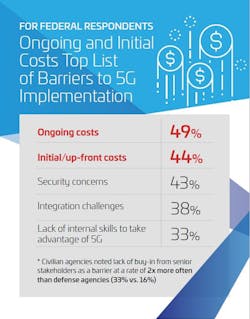Study reveals concerns in current U.S. federal 5G environment
According to a recent study from market research firm Market Connections, underwritten by CommScope, only 46% of U.S. federal government respondents to a recent survey feel their current network infrastructure is capable of supporting 5G, but 68% think 5G will have a significant impact on their agency operations within one to four years.
As noted by the study's summary:
Fifth-generation wireless (5G) is the next major phase of mobile communications. 5G is set to deliver higher data transfer rates for mission-critical communications and will allow massive broadband capacities, enabling high-speed communication across various applications such as the Internet of Things (IoT), robotics, advanced analytics and artificial intelligence.
From April 23 to May 13, 2020, 200 federal government decision makers involved in wired or wireless network and communications infrastructure solutions participated in a blind online survey. Respondents included: 56% federal civilian or independent government agency; 40% defense, military, or intelligence agency; 3% federal judicial branch; and 2% federal legislature.
All respondents had some knowledge of 5G adoption within their agency: 71% evaluate or recommend firms; 65% are on a team that makes decisions; 50% develop technical requirements; 38% manage or implement solutions; 17% make the final decision; and 3% have some other involvement.
Of the survey's respondents who do not feel their current infrastructure is capable of supporting 5G, none have deployed 5G, 19% are piloting, 43% are planning to pilot, and 52% are not planning or evaluating whether to pilot 5G. According to the new report, ongoing and initial costs are reported as top barriers for federal agencies wishing to implement 5G – 44% believe initial/up-front costs will be the biggest barrier and 49% are concerned about ongoing costs.
“There is no single approach to 5G and no one-size-fits-all 5G solution,” commented Chris Collura, vice president, Federal business for CommScope. “This study indicates that federal agencies are at the beginning stages of 5G evaluation and deployment. As they are looking to finalize their strategy for connectivity, agencies should also consider private networks, whether those are private LTE networks, private 5G networks, or a migration from one to the other to ensure flexibility and scalability.”
The study found that remote employee productivity (40%) is one of the top desired outcomes for federal agencies looking to implement 5G, along with introducing high bandwidth (39%), higher throughput (39%) and better connectivity (38%).
Additional findings from the research include:
